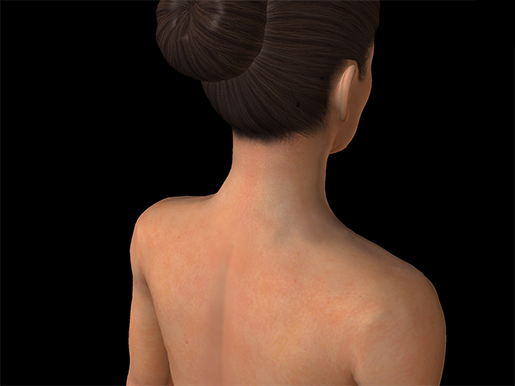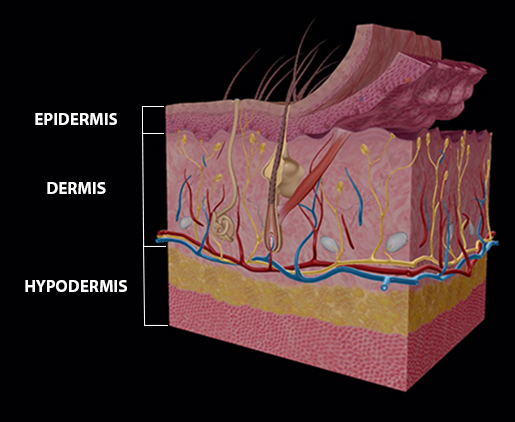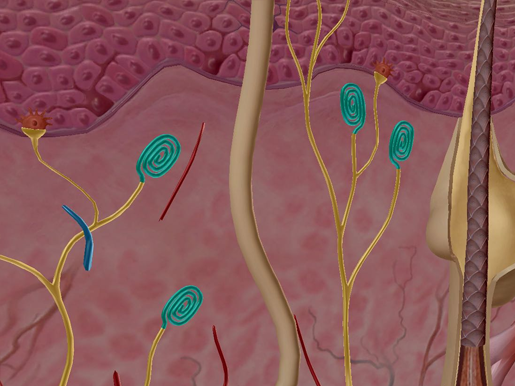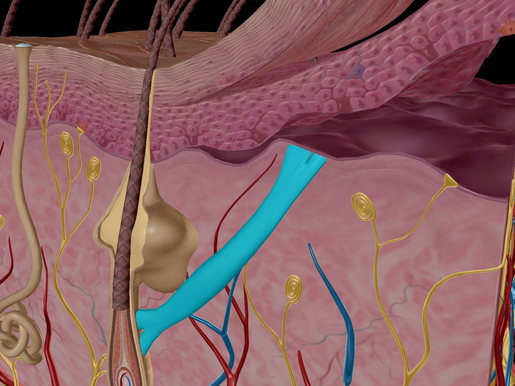Posted on 10/20/15 by Courtney Smith
For all we talk about taking care of our organs, we always seem to leave out one of the most important and obvious. The integumentary system—which is comprised of your hair, nails, and skin—protects everything inside you, acting as a barrier to keep your bones, organs, and muscles safe and sound. It’s one of the many things about our anatomy we take for granted.
The integumentary system is a pretty amazing structure. So amazing, in fact, that it deserves its own post. Let’s take a look at it.
 Image from Human Anatomy Atlas.
Image from Human Anatomy Atlas.
That’s right! The integumentary system is the body’s largest organ, absorbing nutrients (from the sun and other sources), regulating internal body temperature (which is why you’re miserable on hot days, but not as miserable as you could be), and eliminating waste (sweat, anyone?).
It also has a very high cell turnover rate—in one year, you’ll shed over 8 pounds of dead skin! In fact, what you see on your body is dead skin waiting to be sloughed off while everything else is beneath the surface.
Each type of cell contributes to the skin in different ways. The epidermis, the outermost layer of skin, is made up of melanocytes, keratinocytes, Merkel cells, and Langerhans cells. At least two of those should look vaguely familiar to you.
Melanin is pigment, which absorbs ultraviolet rays and determines skin color. The more melanin you have, the darker your skin is.
Keratin is a fibrous protein that protects skin and tissue, and it also is the key structural material in hair and nails.
 The three layers of skin, from Human Anatomy Atlas.
The three layers of skin, from Human Anatomy Atlas.
You probably already knew the skin had layers, but did you know that the skin is categorized by three layers, which are then broken down into sub-layers?
The three main layers of the integumentary system are the epidermis (outermost layer), dermis (middle layer), and hypodermis (innermost layer).
We’ve gone over the epidermis already, but what about the other two layers? The dermis is a thick layer composed mainly of connective tissue rich in collagen and elastin. The dermis stores water, regulates body temperature and the production of vitamin D, cushions the body, and supplies blood to the epidermis.
The hypodermis is the subcutaneous layer and is composed of mainly adipose (fatty) tissue and collagen-rich connective tissue. It separates muscle from skin, stores fat, and conserves body heat.

A cross-section of skin with Meissner's corpuscles highlighted from Human Anatomy Atlas.
There’s a reason you use your hands to feel around in the dark, and it’s not just for balance! Special receptors (free nerve endings) called Meissner’s corpuscles are divvied up around your skin, but are concentrated in places more sensitive to touch, such as your fingers.

A cross-section of skin with an arrector pili muscle highlighted, from Human Anatomy Atlas.
We’ve all experienced goosebumps before—usually when you’re cold or afraid (or, in my case, when you watch the last 20 minutes of Close Encounters of the Third Kind). But have you ever given thought as to what causes goosebumps? What is in your skin that makes it pucker in such a way? The answer is small muscles known as arrector pili.
The arrector pili muscles (one for each hair) extend from the dermis and attach to each hair follicle, just above the bulb. Hair is sensitive to touch, changes in temperature and air, as well as in reaction to an emotion (e.g., hearing beautiful music, seeing something amazing, the last 20 minutes of Close Encounters, etc.), and the arrector pili muscles contract in response to these physical and emotional changes. When the muscles contract, the hairs stand on end.
The integumentary system has a low rate of permeability (a.k.a., it’s hard for things in the environment to penetrate it), which makes it the perfect protector for the rest of the body systems.
Be sure to subscribe to the Visible Body Blog for more anatomy awesomeness!
Are you a professor (or know someone who is)? We have awesome visuals and resources for your anatomy and physiology course! Learn more here.
- Anatomy and Physiology: Stroke Is No Joke: Always Act FAST
- Anatomy and Physiology: The Pharynx and Epiglottis
- Anatomy and Physiology: 7 Facts about Cardiovascular Disease
Additional Sources:
1. Care for conditions from acne to wrinkles
2. Advances in treating eczema and dermatitis
3. Dermatology pictures, Hardin Library for the Health Sciences, University of Iowa
4. A video that shows the development of skin cancer
When you select "Subscribe" you will start receiving our email newsletter. Use the links at the bottom of any email to manage the type of emails you receive or to unsubscribe. See our privacy policy for additional details.
©2024 Visible Body. All Rights Reserved.